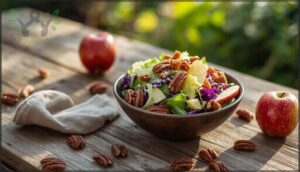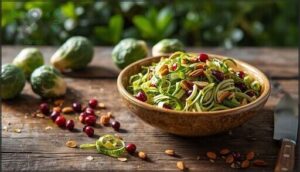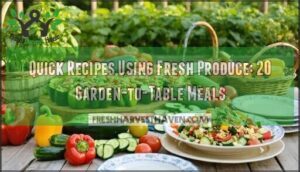This site is supported by our readers. We may earn a commission, at no cost to you, if you purchase through links.

There’s something almost magical about stepping into your garden, picking a sun-warmed tomato, and having it on your dinner table within the hour. The flavor difference is staggering—sweeter, brighter, more alive than anything you’ll find in a grocery store.
Garden-to-table cooking isn’t just a trendy phrase. It’s about reconnecting with food at its freshest, most nutritious peak. When you harvest vegetables at their prime and prepare them simply, you don’t need fancy techniques or complicated recipes to make them shine. The ingredients do the heavy lifting.
Whether you’re growing your own produce or shopping at farmers markets, turning garden-fresh vegetables into memorable side dishes means embracing what’s ripe right now and letting those natural flavors take center stage.
Table Of Contents
Key Takeaways
- Using fresh, seasonal veggies right from the garden or farmers market makes your side dishes tastier and more nutritious.
- Simple cooking methods like roasting, grilling, or tossing salads let the natural flavors of garden produce shine.
- Smart storage tricks—like vacuum sealing and gentle handling—keep your veggies crisp and packed with vitamins longer.
- Supporting local farms and growing your own food helps your community thrive and brings everyone closer to their food.
What is Garden-to-Table Cooking?
Garden-to-table cooking is all about bringing the freshest ingredients straight from the garden to your plate. It bolsters the flavors of each season and aids your local community.
Let’s look at what makes this way of cooking so special.
Key Principles of Garden-to-Table Cuisine
Picture your kitchen as a little farm stand. Garden-to-table cooking is all about Seasonal Eating, Local Sourcing, and Minimal Processing—using homegrown produce and fresh herbs picked at their peak.
You focus on Waste Reduction, Nutrient Density, and Sustainable Food Systems. This approach also emphasizes health benefits, making meals more nutritious.
Every bite celebrates Seasonal Ingredients, making meals taste brighter and feel more meaningful, right from your own backyard.
Benefits of Using Fresh, Local Produce
When you choose locally sourced, organic produce for your garden-to-table sides, you’re getting better flavor and nutrient retention—up to 90% of vitamin C stays in fresh produce! You’re also supporting your local economy and cutting down on emissions. Local food demand also helps support small farms financially. Every bite feels like a win for your family and your community.
- Fresher taste, brighter colors
- Safer, cleaner food
- Stronger local connections
Seasonal Eating and Its Advantages
And when you reach for fresh and seasonal ingredients at their peak ripeness, you’re not just getting the best flavor—you’re boosting your immune function, too. Seasonal cooking lowers your carbon footprint and helps local economies thrive.
Seasonal ingredients at peak ripeness deliver superior flavor, strengthen your immune system, and support local economies while reducing your carbon footprint
Seasonal meal planning means brighter flavors, better nutrition, and more fun in the kitchen. That’s the magic of garden-to-table: every season brings new recipe ideas!
Fresh Garden Salads for Every Season
Nothing beats a crisp salad made with just-picked veggies and herbs. Whether you want something hearty or light, there’s a garden-fresh option for every mood and season.
Here are some of the best salads to brighten up your table.
Green Goddess Salad With Avocado and Basil
Ever tried a Green Goddess Salad bursting with creamy avocado and fresh basil? Avocado benefits like heart-healthy fats and Basil properties that boost your immune system.
The Nutritional comparison is impressive—20g protein and loads of fiber!
Mix up Recipe variations with shrimp or chickpeas, and play with Dressing options using buttermilk or lemon. That’s garden-to-table Recipe Inspiration!
Asparagus Salad With Bacon and Walnuts
With asparagus at its seasonal peak, your garden-to-table cooking gets a burst of freshness. This Asparagus Salad blends crispy bacon (or try smoky tempeh for bacon alternatives), toasted walnut varieties, and a tangy dressing variation.
It’s a healthy side dish packed with fiber and vitamin A.
For storage solutions, keep bacon and walnuts separate—your vegetable recipes will stay garden fresh longer!
Baby Kale and Acorn Squash Salad
On chilly evenings, nothing beats the comfort of a Baby Kale and Acorn Squash Salad. You’ll love its creamy goat cheese, tart cranberries, and sweet roasted squash.
Thanks to Seasonal Sourcing, this GardentoTable side dish bursts with Salad Nutrition and Health Benefits—fiber, vitamins, and antioxidants!
Try Recipe Variations with pepitas or rosemary butter for new Flavor Pairings and Healthy Recipes.
Cabbage and Apple Pecan Salad
With autumn’s arrival comes the perfect excuse to toss together a Cabbage Salad that’s as pretty as it’s practical. This healthy side dish combines crunchy cabbage, crisp apples, and toasted pecans—three Seasonal Ingredients that deliver serious Nutritional Benefits (hello, fiber and vitamin C!). Here’s why you’ll love it:
- Quick 10–15 minute prep for busy weeknights
- Recipe Variations let you swap walnuts or add cranberries
- Storage Tips: keep dressing separate for 3-day freshness
- Consumer Appeal shines with allergen-friendly, gluten-free goodness
- Perfect for Garden to Table Cooking and Summer Salads year-round
Shaved Brussels Sprouts and Cranberry Salad
This showstopper salad turns raw Brussels sprouts into delicate ribbons that pair beautifully with tart cranberries and crunchy almonds. Prep methods are simple—just 15 minutes with a mandoline or sharp knife.
You’ll get impressive Salad Nutrition: 222 calories, 25% daily fiber, and 88% vitamin K per serving. The Cranberry Benefits include heart-healthy antioxidants, while Ingredient Trends show Brussels sprouts gaining serious popularity nationwide.
Low-Calorie Garden Salad Options
Looking for a side dish that’s light as a feather but still packs a punch? GardenFresh Side Dishes like leafy salads deliver Calorie Counts as low as 24 per cup, especially with smart Dressing Choices.
You’ll enjoy Fiber Benefits and Nutrient Density from Fresh Vegetables—perfect for Weight Management.
Healthy Eating gets easy when you build Healthy Side Dishes from simple, vibrant Garden Recipes.
Roasted and Grilled Vegetable Sides
When you want veggies that steal the show, roasting and grilling bring out their best flavors. There’s something magical about caramelized edges and smoky notes straight from the oven or grill.
Let’s look at a few garden favorites you’ll want on your table.
Roasted Carrots With Honey Herb Butter
Ever wondered why Roasted Carrots with honey herb butter taste like pure sunshine on a plate? Roasting time variations let you dial up crisp edges or tender bites. Try different carrot varieties—each brings its own magic. Sweetness enhancement tips? Use fresh, peak-season carrots! Nutritional benefits retained are high, making this a star in garden to table recipes and healthy side dishes.
- Wash carrots well
- Slice for even roasting
- Toss with honey herb butter
- Roast 25-40 minutes
- Serve warm and enjoy
Crispy Roasted Broccoli and Asparagus
If honey butter carrots brighten your table, crispy Roasted Broccoli and Asparagus bring pure garden crunch. Roast at 425°F for golden edges—don’t crowd the pan! Try garlic, lemon zest, or Parmesan for bold Flavor Combinations. These Side Dishes pack Health Benefits and store well, making them stars in Vegetable Cooking.
Here’s a quick look:
| Roasting Temp | Texture Techniques | Storage Solutions |
|---|---|---|
| 425°F | Broil for crispness | Up to 3 days chilled |
| 400°F | Separate veggies | Airtight containers |
| 415°F | Dry before roasting | Use as salad toppers |
Grilled Veggie Skewers With Balsamic Marinade
If you love crispy broccoli, you’ll flip for Grilled Veggie Skewers. These garden-fresh recipes feature a rainbow of spring veggies, soaking up balsamic health benefits in every bite.
Prep time is quick—just 15–30 minutes! Grilling enhances nutrient impact, meaning more flavor and antioxidants.
No wonder these Summer Side Dishes rank among the most popular garden-to-table grilling recipes.
Roasted Artichokes With Lemon Aioli
After the smoky goodness of veggie skewers, roasted artichokes with lemon aioli are a true showstopper. Their nutty flavor shines after 40–55 minutes in the oven.
You get Artichoke Health Benefits—fiber, antioxidants, and potassium—plus the creamy Aioli Flavor Pairings.
For Summer Side Dishes, serve one artichoke per person. Sustainable Artichokes make GardentoTable Recipes feel extra special.
Garlic-Sesame Green Beans
If you want a lightning-fast side, garlic-sesame green beans are your answer. They’re ready in 12–15 minutes and pack around 67 calories per serving.
Sautéed Green Beans with toasted sesame oil deliver nutritional benefits like vitamin C and potassium. Try different cooking techniques—stir-fry or steam—and experiment with flavor combinations.
These Garden Fresh Recipes prove fresh vegetables shine in simple Garden-to-Table Recipes with endless recipe variations and serving suggestions.
Unique Seasonal and Stuffed Vegetable Dishes
Sometimes the best garden-to-table sides aren’t just roasted or tossed—they’re stuffed, layered, or cooked into something truly special.
These dishes celebrate seasonal produce in ways that feel a little more creative and comforting.
Here are five unique vegetable recipes that’ll bring warmth and wow-factor to your table.
Stuffed Tomatoes With Sausage and Cheese
Picture juicy garden-fresh tomatoes transformed into savory treasure chests! This classic Taste of Home recipe combines sausage, onions, bell pepper, and cheese for irresistible homemade side dishes. You’ll love the cooking techniques—just hollow the tomatoes, stuff them, and bake until golden.
Recipe variations include turkey sausage for dietary adaptations, while the nutritional value offers protein and lycopene. These stuffed tomatoes shine at gatherings, bringing food and gardening together beautifully.
Creamed Corn With Summer Sweetness
With summer’s peak, fresh corn bursts with natural sugars—up to twice the sweetness of standard varieties. This thick, creamy dish captures those garden-fresh flavors in 30-45 minutes.
You’ll get valuable fiber, vitamin A, and antioxidants for eye health. Try adding lime zest or cayenne for culinary technique variations, or use the corn “milk” from cobs to intensify that irresistible summer sweetness.
Classic Ratatouille With Layered Vegetables
From its Provençal origins, this classic ratatouille layers eggplant, zucchini, and tomatoes into one stunning dish. You’ll love how simple cooking techniques—thinly slicing fresh vegetables and slow-baking them—create deep flavor profiles without fuss.
At just 144 calories per serving, you get 4 grams of fiber plus antioxidants for heart health.
Try summer ratatouille variations with basil or thyme to make seasonal food shine.
Spinach Casserole With Crunchy Topping
You’ll find spinach casserole packed with nutritional benefits—424 micrograms of vitamin K and 459 milligrams of calcium per serving! This vegetarian cooking favorite shines during holiday traditions, especially in Southern states.
Layer your spinach with cheese selection like feta or cheddar, then crown it with topping variations such as breadcrumbs or crackers. These serving suggestions make vegetable recipes exciting, offering recipe inspiration and ideas that transform simple home cooking into something special.
Pea and Mint Risotto
This spring classic delivers 389 calories and 14 grams of protein per serving—perfect for seasonal food and cooking! Fresh herbs and garden peas create a creamy, vibrant dish that’s naturally low in phosphate and potassium.
You can easily make vegan adaptations by swapping dairy for plant-based alternatives, or boost it with chicken for protein enrichment. Gluten-free options work beautifully, making this adaptable for dietary restrictions.
Just remember reheating safety: heat thoroughly and enjoy within one day for the best home cooking and meal preparation experience!
Tips for Freshness, Nutrition, and Storage
You’ve picked your produce at peak ripeness—now let’s talk about keeping it that way. The right storage methods and a few smart kitchen tricks can help you lock in all that fresh flavor and nutrition.
Here’s how to make the most of your garden-to-table ingredients while supporting the folks who grow them.
Maximizing Flavor and Nutrients From Harvest
Want to squeeze every drop of flavor and nutrition from your kitchen garden? Timing is everything. Here’s how to make your farm-to-table dishes shine:
- Harvest early morning when vegetables are crisp and moisture-rich for maximum flavor enhancement.
- Cook or eat immediately to lock in nutrients—fresh vegetables lose vitamin C fast after picking.
- Use gentle cooking methods like steaming or roasting to preserve nutritional value.
- Handle with care post-harvest to protect delicate nutrients and natural sweetness.
Using Kitchen Tools for Garden-Fresh Sides
Once you’ve picked those peak-flavor vegetables, the right kitchen tools make all the difference. Sharp knives preserve nutrients by minimizing cell damage during cutting. Salad spinners dry greens fast, keeping them crisp. Spiralizing veggies transforms zucchini into fun noodles. Julienne peelers create elegant strips in seconds.
| Tool | Garden Veggie Use | Time-Saving Benefit |
|---|---|---|
| Chef’s Knife | Dicing tomatoes, peppers | Safe, efficient cuts |
| Salad Spinner | Washing leafy greens | 50% faster drying |
| Spiralizer | Zucchini noodles | 40% quicker than knife work |
| Y-Peeler | Carrots, squash | Professional speed peeling |
| Mandolin | Uniform cucumber slices | Consistent thickness |
Investing in quality, sustainable tools means you’ll prep garden-fresh sides faster while protecting those hard-won nutrients.
Vacuum Sealing Garden Produce for Longevity
After prepping your garden-fresh sides, vacuum sealing preserves that just-picked flavor for months. This fresh preservation method removes oxygen, slowing spoilage and extending shelf life by three to five times. You’ll maintain nutrients better than conventional storage while supporting sustainable cooking practices.
Blanch delicate greens first, then seal firm veggies like peppers and green beans for food safety and maximum produce longevity.
Supporting Local Farms and Community Markets
When you shop at farmers markets, you’re strengthening local food systems and the farm economy. This farm-to-table choice bolsters the locavore movement and sustainable cooking.
Nearly 48% of market-goers report deeper community outreach connections, while sustainable agriculture practices grow yearly. Plus, you’ll discover fresh produce recipes and seasonal recipe ideas while contributing to impressive market growth that keeps small farms thriving.
Frequently Asked Questions (FAQs)
How do you preserve fresh herbs long-term?
Let’s “leaf” nothing to chance—herb drying, freezing methods, oil infusions, salt preservation, and freeze-drying all work wonders. These food preservation tricks keep your kitchen gardening bounty fresh for cooking with herbs and even Herb and Cherry Tomato Flatbread.
What vegetables grow best in small gardens?
Compact Tomatoes, Container Carrots, Leafy Greens, Small Peppers, and Vertical Climbers thrive in small gardens.
With smart garden planning, you’ll enjoy fresh produce for cooking—think heirloom tomato salads and snappy greens—straight from your kitchen garden!
Can you freeze garden vegetables without blanching?
You can freeze garden vegetables without blanching, but enzyme deactivation won’t happen, so expect texture degradation and freezer burn—especially with high-water veggies. Raw freezing works for tomatoes and herbs.
Try blanching alternatives for better quality in your summer harvest.
How do you prevent bugs on homegrown produce?
Picture sun-warmed tomatoes glistening in your kitchen garden—no bug bites in sight. To keep produce bug-free, use organic pesticides, physical barriers, companion planting, IPM strategies, and regular pest monitoring.
These Gardening Tips make FarmtoTable freshness possible.
What are the best beginner-friendly garden vegetables?
If you’re new to organic gardening, start with easy leafy greens like lettuce and Swiss chard, simple root crops like radishes and carrots, and low-maintenance legumes.
Additionally, consider fruit-bearing vegetables such as cucumbers and beginner-friendly herbs for your kitchen garden.
Conclusion
You might worry your garden isn’t big enough or your skills aren’t fancy, but the best garden to table side dishes come from simple joy and curiosity.
Every tomato, squash, or bean you pick is a chance to connect with your food and the people you share it with. Let your table reflect the season’s generosity.
Fresh flavors, laughter, and a little dirt under your nails—there’s nothing more delicious or rewarding than that.
- https://www.tasteofhome.com/collection/garden-produce-side-dishes/
- https://www.eatthismuch.com/calories/side-of-fresh-vegetables-1871623
- https://www.atlantichealth.org/health-articles/nutrition/the-benefits-of-eating-local-produce
- https://www.friendofafarmer.com/blog/farm-to-table-impacts-your-local-economy
- https://www.produceleaders.com/seasonal-eating-trends-and-produce-demand/












